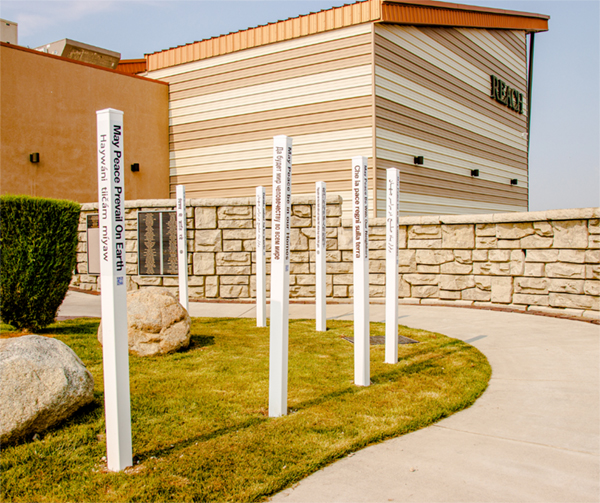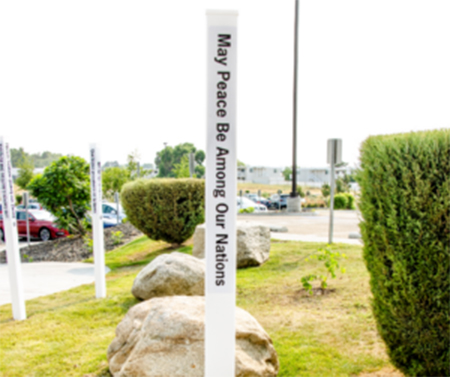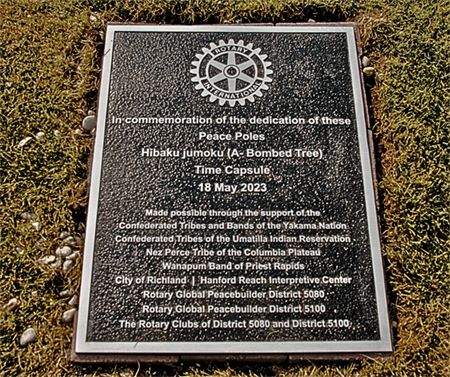100 Peace Poles across the four sponsoring Rotary Districts of WGIPPA – Richland, Washington-USA
Submitted, July 2024

At the heart of the Peace Pole Project lies a profound endeavor to spread the message of peace far beyond borders. The collaboration between the Reach Foundation and the REACH Museum is a celebration of cultural heritage, aimed at empowering communities and individuals with the spirit of unity and harmony.
Inspired by the Waterton Glacier International Peace Park Association (WGIPPA), the Peace Pole project commenced in 2022, marking the beginning of a decade-long effort to plant 100 Peace Poles across the four sponsoring Rotary Districts of WGIPPA – 5080, 5360, 5370, and 5390. These peace poles serve as enduring symbols, adorned with the universal inscription “May Peace Prevail On Earth,” resonating across languages and cultures.


The Peace Pole Project encapsulates the Reach Foundation’s unwavering dedication to nurturing understanding and promoting unity. The peace poles, engraved with languages including English, Spanish, Japanese, Sahaptin (Umatilla), French, American Sign Language, Italian, Hebrew, Arabic, and more, reflect the rich diversity of human expression. Through these languages, we echo a single call for harmony that transcends boundaries.
The Dedication Ceremony
On 18 May 2023, a momentous dedication ceremony was held at the Hanford Reach Interpretive Center in Richland. The ceremony witnessed the planting of a Hibakujumoku (atom bomb tree), a poignant symbol of resilience and hope, alongside the peace poles. A time capsule and commemorative plaque were also placed, honoring the contributions of Indigenous Tribes, Rotary Districts and Clubs, local communities, and organizations that embraced this initiative.
Our Commitment to Sustainability
Supported by the generosity of Peacebuilder Rotary Clubs in Districts 5080 (Washington, Idaho, British Columbia) and 5100 (Northern Oregon), the Peace Pole Project embodies our dedication to a lasting impact. Part of the funding has been allocated to the REACH Museum, ensuring the perpetual preservation and maintenance of the site, allowing the legacy of peace to thrive.
Join Us in Embracing Peace
Become a part of this remarkable journey towards unity and understanding. Explore the legacy of the Peace Pole Project and its profound impact on cultural heritage and education. Join hands with the Reach Foundation and the REACH Museum as we celebrate diversity and promote a world where “May Peace Prevail On Earth.” www.peacepoleproject.org at www.worldpeace.org

The Hibakujumoku, also known as the Atom Bomb Tree, stands as a poignant testament to the enduring resilience of Hiroshima, Japan, in the aftermath of the devastating atomic bombing during World War II. This remarkable tree, a hibaku (survivor) of the blast, has become a symbol of hope and rejuvenation, exemplifying nature’s ability to persevere even in the face of unthinkable destruction. Its branches, which miraculously survived the explosion’s intensity, serve as a living reminder of the city’s past while embodying a powerful message of peace, resilience, and the urgent need for nuclear disarmament. The Hibakujumoku stands as a living witness to the horrors of war and the human capacity to heal and rebuild, inspiring generations to come with its message of unity and the pursuit of a world free from nuclear conflict.
The site was the closest to the reactor where the nuclear material was made for the Hiroshima bomb in the Manhattan Project.
Click here to visit The Reach Museum: https://visitthereach.us/peace-pole-project/
